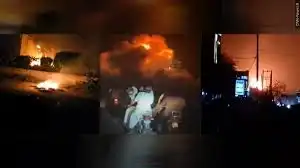India Strikes Pakistan After Kashmir Attack; Pakistan Claims 5 Indian Jets Shot Down

India Strikes Pakistan After Kashmir Attack;
Tensions between India and Pakistan have escalated after a deadly attack in Jammu and Kashmir. India launched airstrikes across the border, targeting what it said were terrorist camps. In response, Pakistan claimed it shot down five Indian fighter jets.
Kashmir Massacre Triggers Conflict
The conflict began after a brutal attack in Jammu and Kashmir. Militants ambushed a convoy in Pulwama, killing over 40 Indian paramilitary personnel. It was one of the deadliest attacks in the region in years.
India blamed the Pakistan-based group Jaish-e-Mohammed (JeM) for the attack. Officials said they had clear intelligence linking JeM to the incident. They also said JeM was operating from inside Pakistani territory.
India’s Airstrikes Across the Border
In retaliation, India carried out airstrikes across the Line of Control. The government said it targeted a JeM training camp. Indian officials described the strike as “preemptive” and “non-military.”
India’s Foreign Secretary said the strike aimed to prevent future attacks. He added that the camp housed many terrorists and their leaders. The operation was said to be carried out with “surgical precision.”
Pakistan Responds with Aerial Action
Pakistan denied the Indian claims and responded with force. Its military confirmed that Indian planes entered Pakistani airspace. Pakistani jets intercepted them and forced them to retreat.
Later, Pakistan claimed it shot down five Indian aircraft during the confrontation. It also said one Indian pilot was captured. The military released photos and videos showing the captured man in uniform.
India confirmed that one pilot was missing. The government demanded his immediate return. It also criticized the video footage as a breach of the Geneva Conventions.
Clashes Along the Border
After the airstrikes, military activity increased on both sides of the Line of Control. Shelling was reported in multiple areas. Civilians living in the region panicked.
Thousands of residents near the border were evacuated. Schools were shut down. Emergency shelters were set up to protect civilians from further violence.
World Leaders Call for Restraint
The international community has expressed concern over the situation. Countries like the United States, China, and Russia urged both nations to show restraint. The United Nations also issued a statement calling for calm.
Many leaders offered to mediate peace talks. They stressed that both sides must avoid further escalation. Concerns grew about the risk of war between two nuclear-armed countries.
Human rights groups echoed the call for peace. They said civilians in Kashmir suffer the most during these conflicts. These groups urged both governments to return to the negotiating table.
Kashmir: A Long-Standing Conflict
Kashmir has been a source of conflict since India and Pakistan became independent in 1947. Both countries claim the region but only control parts of it. Two of their three wars were fought over Kashmir.
India accuses Pakistan of backing militants in Kashmir. Pakistan denies this. It accuses India of committing human rights violations in the region.
The situation worsened after India revoked Kashmir’s special status in 2019. Since then, tensions have remained high.
Social Media Fuels the Fire
Media coverage in both countries has been intense. National pride has driven many of the headlines. Social media has played a big role in spreading information—and misinformation.
Hashtags like #IndiaStrikesBack and #PakistanZindabad trended on Twitter. At the same time, fake news also spread widely. Experts warned that such misinformation could increase tensions even more.
What Comes Next?
So far, reports from both sides differ. India claims success in its airstrikes. Pakistan denies any damage and says it successfully defended its territory. Independent verification is difficult due to limited access to the area.
Both governments say they want peace. Yet their actions suggest otherwise. Diplomatic talks are said to be happening behind the scenes.
Analysts say domestic politics may be pushing both sides toward conflict. National pride, media pressure, and upcoming elections can all influence decisions.
For civilians living near the border, fear and uncertainty are growing. Many worry that this may not be the end of the fighting.
Final Thoughts
The situation between India and Pakistan remains tense. A single incident in Kashmir has triggered a series of dangerous events. The possibility of war looms large.
Now more than ever, diplomacy is needed. The world is watching. Peace, not pride, must lead the way forward.






